Sendible insights Social Media Accessibility: Everything You Need to Know About Alt Text on Social Media
Social media has helped change the lives of the people in the Deaf community. It provided them with the means necessary to get involved daily with the online community and express themselves through various formats.
But did you know that there's a way to make your content accessible to people with limited vision?
Every community should have access and opportunity to enjoy your social media content, which is why it's crucial for your brand to start utilising features that make it inclusive.
So, how do you make it easily accessible? By adding alt text to your image posts.
- What is alt text on social media
- What is the difference between alt text and caption
- Why should you start adding alt text to your social media images
- How to write meaningful alt text
- How to add alt text on different social media platforms
What is alt text on social media
Alt text (also called alt tag or alternative text) is the written copy that explains the image. And when someone mentions it, we immediately think of the SEO benefits such as allowing search engines to better crawl and rank your website and filling in the gap when the image fails to load on a user's screen.
It's only after a couple of minutes that we remember that alt text actually plays a crucial part in improving web accessibility as this text helps screen-reading tools describe images to visually impaired readers.
Alt text on social media has the exact same role - it helps the algorithm understand better your image post while making it even more accessible to people with visual impairment.
What is the difference between alt text and caption
There is a bit of confusion around whether it's necessary to use alt text on social media, as screen-reading tools detect captions making the image accessible.
Here are the two main differences that should help resolve this puzzle:
- Captions are visible, alt text is not. A social media caption is a text-based copy that follows the visual part of the post. Alt text is either available to the user as an HTML attribute or through an accessibility tool.
- A caption is topic-first, and alt text is image-first. A good caption is all about the topic of the post, it highlights key points, encourages engagement, and includes a strong call to action. Alt text on the other hand explains what is represented in the image.
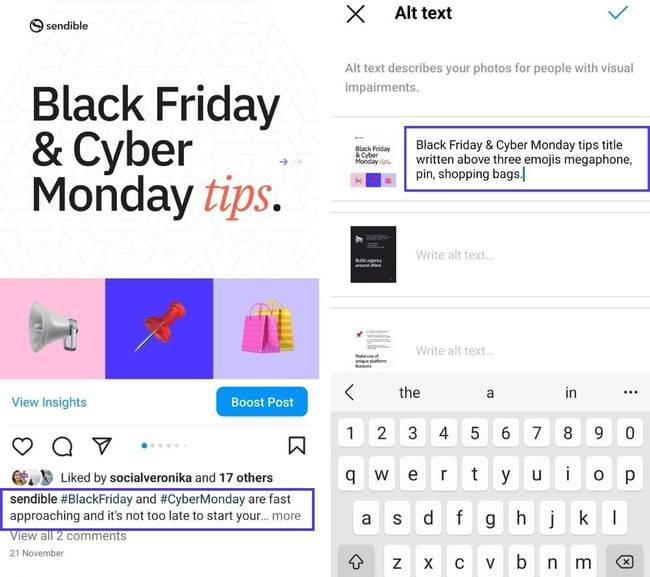 Caption on the left (visible), alt-text on the right (in the backend).
Caption on the left (visible), alt-text on the right (in the backend).
Why should you start adding alt text to your social media images
There are many reasons why you should start adding alternative text to your social media posts, but these three are the most important ones:
- Alt text makes your social media images easily accessible to all members of the community. And your social media strategy should aim to be inclusive.
- Making your content accessible by anyone translates to better discoverability and increased brand awareness.
- Improved accessibility means more people can enjoy your content, and this has a direct impact on your engagement rate and, ultimately, business goals.
How to write meaningful alt text
There's no doubt that alt text improves the chances of your content being discovered and enjoyed by all members of your existing social media community.
But it can also help you reach a much wider target audience and gain new followers - if you write it the right way.
Before we check out the good alt text example, here are some tips to keep in mind:
- Keep it short (around 100-200 characters)
- State the type of the image (illustration, photo, etc)
- Focus on describing the image itself, not the topic
- If an image has a text overlay, ensure to include it in your alt text
- Use a relevant keyword when describing your image
- Avoid using emojis as screen-reading tools read them quite literally
Let's take this Instagram post by Starbucks as an example:
 Source: @starbucks
Source: @starbucks
The caption Together at last 💚 makes a lot of sense when paired with the image of their famous Christmas edition of beverages. But a visually impaired person that stumbles upon this post will remain puzzled. Does the image represent a family? Team reunion? A delicious combination of the Chestnut Praline Latte and freshly baked muffin? They won't even know that the post is about the holiday season!
In case you didn't really understand why alternative text description is so important, I hope you do now.
Here's what a good alt text could look like for this image:
A photo of six signature holiday season Starbucks cups placed on snow, surrounded by tiny Christmas trees.
This alt text is short (107 characters), states the type of the image (photo), describes what is represented on the image, and includes a keyword (holiday season Starbucks).
Bonus tips: To keep your alt text descriptive, but short, try to avoid listing. You can always add a list to the caption. You'll notice that instead of disclosing each flavour, we said "signature" as everybody's familiar with the traditional Starbucks holiday beverages.
How to add alt text on different social media platforms
Facebook uses automatic alt text (AAT) - object recognition technology to provide a visual description of photos for people with visual impairments. While this can come in handy, you should still consider replacing this text to provide a better description of the image and include the above-mentioned tips.
Here are the steps:
- Select and upload the image
- Click Edit
- Select "Alternative Text"
- Click Custom Alt Text to override the automatic one
- Once you write your own text, click save
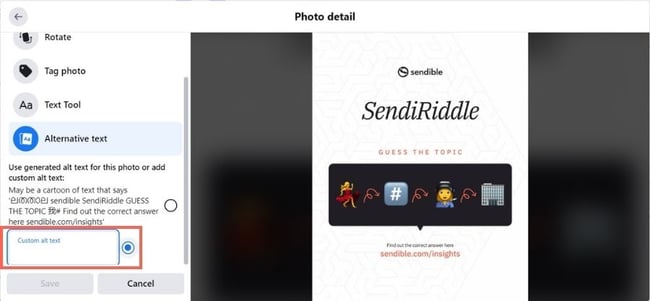
Instagram uses the same automatic alt text technology as Facebook does. Follow these steps to edit it and ensure your post is optimised just the way you want it:
- Select and upload the image
- Tap Next (iPhone) or -> (Android)
- Tap Advanced Settings at the bottom of the screen
- Tap Write Alt Text
- Write your alt text in the box and tap Done (iPhone) or (Android)
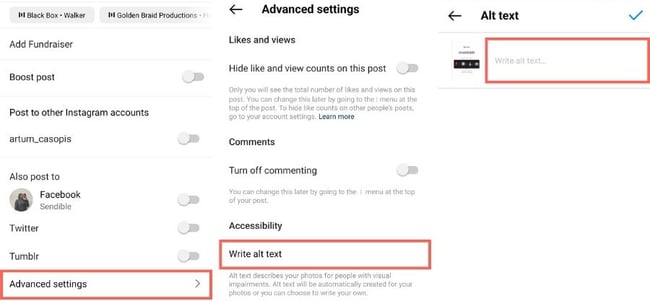
Important note: Instagram Carousel offers you the possibility to write alt text for each image. This is especially convenient if your post is explaining particular steps, tips, or notes.
Twitter, now called X, doesn't use ai generated alt text, so you'll have to add your own. And you can do so in four easy steps:
- After uploading an image to a Tweet, select Add description underneath the image
- Enter a description of the image in the text box (up to 1000 characters)
- Click Save
- Click Tweet when your post is ready to be published
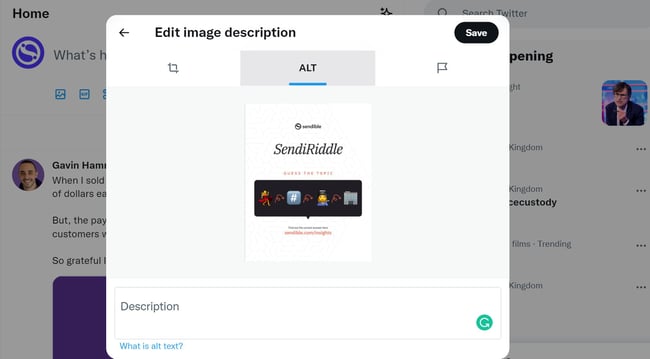
If you want users to have an inclusive experience, you should start adding alt text description to the images you share on your LinkedIn feed or embed in articles.
- Upload an image
- Click Alt. text on desktop, or three dots then Alt text on mobile
- Add alt text
- Click Done
- Click Post once you're ready to publish it
In the case of articles simply:
- Upload the image
- Click Add alt text at the top right corner
- Write descriptive text
- Click Save
Imporant note: LinkedIn states that it may automatically add alt text to images that don’t have it.
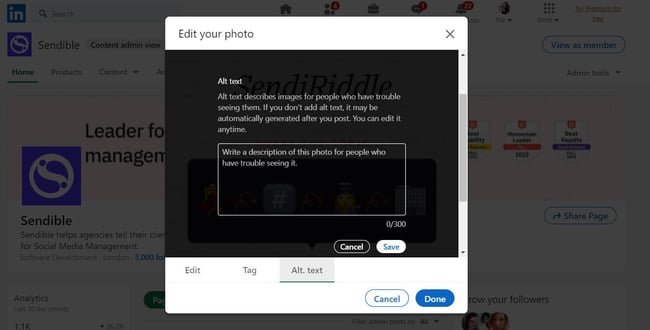
Text copied!


